Leroy C., Rancoita P.-G. Principles Of Radiation Interaction In Matter And Detection
Подождите немного. Документ загружается.


January 9, 2009 10:21 World Scientific Book - 9.75in x 6.5in ws-bo ok975x65˙n˙2nd˙Ed
730 Principles of Radiation Interaction in Matter and Detection
and isotropic and consequently, the recoil energy distribution dn
i
/dE
i
R
= 1. Equa-
tion (10.8) becomes:
²
i
(E
n
, T ) =
1
E
i
R,max
Z
E
i
R,max
E
i
R,min
P (E
i
R
, E
i
R,th
(T )) dE
i
R
. (10.9)
Using E
i
R,max
= f
i
E
n
and E
i
R,min
= f
i
E
i
th
, we can rewrite Eq. (10.9) as:
²
i
(E
n
, T ) = 1 −
E
i
th
(T )
E
n
−
·
1 − exp
µ
−α
E
n
− E
i
th
(T )
E
i
th
(T )
¶¸
E
i
th
(T )
αE
n
. (10.10)
A detailed description of the neutron data has to include the energy dependence of
the neutron cross section on
12
C and
19
F, which contains many resonances in the
energy region relevant to our example. One can determine the parameters α and
E
i
th
(T ) in Eq. (10.10) and, therefore, the efficiency ²
i
(E
n
, T ), from the measured
count rate (per second), R(E
n
, T ), of liquid-to-vapor transitions for monoenergetic
neutrons of energy E
n
at temperature T :
R(E
n
, T ) = Ψ(E
n
) V
l
Σ
i
²
i
(E
n
, T ) N
i
σ
i
n
(E
n
), (10.11)
where Ψ(E
n
) is the flux of monoenergetic neutrons of energy E
n
, V
l
is the volume
of the superheated liquid, N
i
and σ
i
n
(E
n
) are the atomic number density of species
i in the liquid and the corresponding neutron cross section, respectively. The fit of
Eq. (10.11) to the data, giving the count rate as a function of the neutron energy, is
shown in Fig. 10.5 for different temperatures. It gives an exponential temperature
dependence for E
i
th
(T ). The efficiency ²
i
(E
n
, T ) is obtained from the fit, as well as
α = 1.0 ± 0.1, found to be temperature independent.
In general, the cross section, σ , of neutron–nucleus interaction is the sum of two
terms:
σ = σ
SD
+ σ
C
, (10.12)
where σ
SD
and σ
C
are the spin-dependent and coherent cross sections, respecti-
vely. The coherent cross section goes like A
2
(A being the atomic mass number of
the nucleus, see Sect. 3.1). In the case of the CDM search experiment PICASSO, the
data are analyzed by exploiting the feature that the interaction of neutrons, with
the superheated carbo-fluorates, is dominated by the spin dependent cross section
on
19
F, due to a dominant magnetic term in
19
F (σ
SD
>> σ
C
). One should note
that the interaction of neutrons with superheated active gas containing bromine
(A ∼ 80) would be dominated by the coherent cross section. The possibility to
fabricate superheated droplet detectors with an active gas containing bromine has
to be investigated. Returning to our present case, the minimum detectable recoil
energy for
19
F nuclei is extracted from E
i
th
(T ) and is given by [Boukhira et al.
(2000)]
E
F
R,min
(T ) = 0.19E
F
th
= 9 (keV) × exp
µ
−
T − 20
6.45
¶
. (10.13)

January 9, 2009 10:21 World Scientific Book - 9.75in x 6.5in ws-bo ok975x65˙n˙2nd˙Ed
Superheated Droplet (Bubble) Detectors and CDM Search 731
Combining Eqs. (10.7, 10.13), one finds the droplet phase transition probability as
a function of the recoil energy deposited by a
19
F nucleus when it is struck by a
neutron. For instance, at T = 20
◦
C, E
F
R,min
= 9 keV and
P (E
R
, E
F
R,min
) = 1 − exp
·
−1.0 (E
R
− 9 keV)
9 keV
¸
.
For E
R
= 30 keV and 15 keV, P (30 keV, 9 keV)= 0.9 and P (15 keV, 9 keV)=
0.49. The sensitivity curve shows that the detectors are 80% efficient at 30
◦
C for
E
R
≥ 5keV recoils and at 20
◦
C for E
R
≥ 25 keV recoils. This sensitivity is ex-
ploited in cold dark matter search [Boukhira (2002)]. Knowing the
19
F nuclei recoil
spectrum expected from neutralino interactions and knowing the detector response
as function of temp erature [Eqs. (10.7, 10.13)], it is possible to determine the detec-
tor efficiency for a given neutralino mass and a given operating temp erature. The
temperature dependence of the detection efficiency provides a way to discriminate
against background contributions.
In the case of a polyenergetic beam, such as a radioactive source, one has to
integrate Eq. (10.11) over the neutron energy spectrum:
R(T ) =
Z
E
n,max
0
ψ(E
n
) ²
i
(E
n
, T ) σ
i
n
(E
n
) dE
n
, (10.14)
where ψ(E
n
) is the neutron spectral-flux (Sect. 4.1.3); σ
i
n
(E
n
) is known from tables
of neutron cross section on
12
C and
19
F and ²
i
(E
n
, T ) has been obtained above. For
a given neutron energy spectrum at low temperature only the high energy neutrons
take part in the process of liquid-to-vapor transition. Since the threshold energy
is decreasing as the temperature increases (Fig. 10.4), low energy neutrons, in ad-
dition to high energy neutrons, are also detected. So, for a polyenergetic neutron
source, ²
i
(E
n
, T ) should increase with temperature. At high enough temperature,
all the neutrons in the spectrum are contributing to phase transitions and ²
i
(E
n
, T )
becomes constant with temperature since no other neutrons will add their con-
tribution to phase transitions. For a monoenergetic neutron source, there is only
one strong increase of ²
i
(E
n
, T ) at the operation temperature corresponding to the
energy of phase transition and ²
i
(E
n
, T ) is constant for higher temperatures. The
use of droplet detectors as neutron spectrometers is based on the possibility to
make the detector sensitive to different ranges of neutron energies by varying the
temperature of operation.
In order to unify the presentation of count rates and minimal neutron energy
for detectors with different neutron threshold energies, it is convenient to use the
reduced superheat parameter, s, defined in Eq. (10.2). As can be seen in Fig. 10.6,
the minimal neutron energy, or threshold energy, is an exponential function of s:
E
th
= E
0
e
−α
s
(s−s
0
)
, (10.15)
where α
s
and E
0
are two parameters to be fitted from the data. E
0
is the threshold
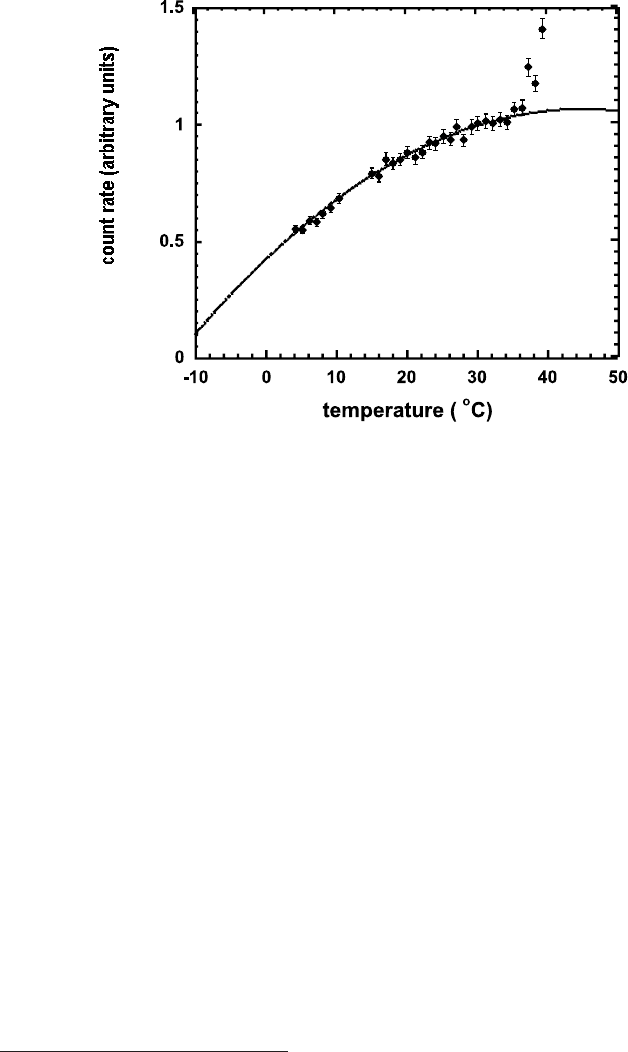
January 9, 2009 10:21 World Scientific Book - 9.75in x 6.5in ws-bo ok975x65˙n˙2nd˙Ed
732 Principles of Radiation Interaction in Matter and Detection
Fig. 10.8 Response of a 1.5 l detector (loaded with 100% C
4
F
10
) to α-particles emitted from the
gel, doped with 20 Bq
232
U. Above 38
◦
C, the detector becomes sensitive to background gamma-
rays [Barnab´e-Heider et al. (2002)].
energy at a value of reference s = s
0
. With parameter s, the response
∗
for different
gases is computed with T
c,eff
= 0.9 T
c
.
Figure 10.7 shows the response of two detectors (1 and 2 have different active
gases and hence have different neutron energy thresholds) to neutrons from an AcBe
source as a function of reduced superheat.
10.1.2 Alpha-Particle Response Measurement
The α-particles produced outside the superheated droplet detectors cannot be de-
tected. Due to their short range in matter, α-particles are stopped in the detec-
tor wall. Only α-particles produced within the volume of the detector can be de-
tected. The heavy salt used to equalize densities of droplets and solution and other
ingredients mixed in the gel at the present stage of detector fabrication contains
α-emitters, such as U/Th and daughters. This α-background is the ultimate back-
ground at normal temperatures of superheated droplet detectors operation in CDM
search experiments since other backgrounds, such as γ-rays and mip’s, contribute
only to the detector signal at higher temperature. The α-response is studied with
detectors doped with a source (
232
U or
241
Am) of a known α-activity, introduced as
a soluble salt, and uniformly distributed in the polymerized gel, but not present in
∗
Vaporization for organic liquids takes place at an absolute temperature which is about 90% of
the critical temperature at atmospheric pressure [Eberhart, Kremsner and Blander (1975)].
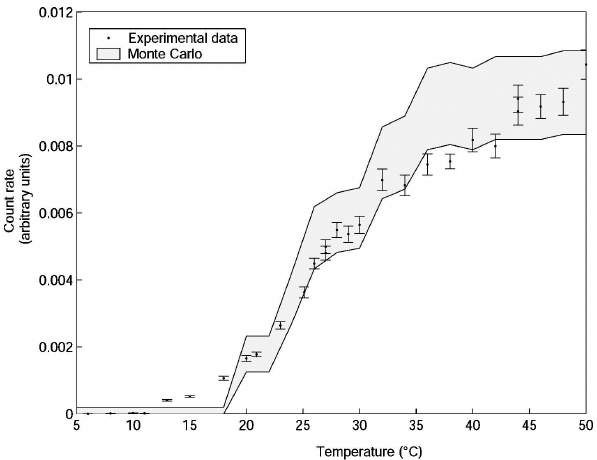
January 9, 2009 10:21 World Scientific Book - 9.75in x 6.5in ws-bo ok975x65˙n˙2nd˙Ed
Superheated Droplet (Bubble) Detectors and CDM Search 733
Fig. 10.9 Detector response (count rate) of a 1 l detector loaded with a 100% C
4
F
10
gas (loading
of 0.7%), whose gel is doped with 20 Bqs of
241
Am as a function of temperature. A critical length
of L = 18 R
c
is necessary to fit the data [Barnab´e-Heider et al. (2004)].
the droplets themselves, since the source compounds used in these spiked detectors
is hydrophilic and the freon droplets are hydrophobic.
Figure 10.8 shows the measured response of a 0.7% droplet loading detector to
α-particles emitted from the gel doped with 20 Bq
232
U. Above 38
◦
C, the detector
becomes sensitive to background γ-rays. Previous studies were performed with a
detector of the same loading [Boukhira et al. (2000)] doped with 10 Bq
241
Am. It
was observed that the count rate increases above 0
◦
C and stays nearly constant
from 20 to 40
◦
C at a level of about 3 counts per minute. From the droplet di-
stribution, the range of α-particles and the activity per unit volume, 8 counts per
minutes is expected from geometrical considerations. Thus, 0.5% of the α-particles
are detected in a plateau region. Above 40
◦
C, the count rate increases fastly. Monte-
Carlo studies [Barnab´e-Heider et al. (2004)] have been performed, where α-particles
were randomly generated in the gel with an energy spectrum corresponding to the
241
Am decay. These Monte-Carlo studies indicate that the experimental efficiency
is too high for the phase transition to be caused by elastic collisions between α-
particles and nuclei in the droplets. This leads to the suggestion that the phase
transition is triggered by the α-particles ionization loss in the droplets. The fabri-
cation process leads to no diffusion of
241
Am in the droplets and the experimental
efficiency is low enough, to discard surfactant effect as described in [Pan and Wang
(1999)]. Under those assumptions, the contribution of the recoil short-range
237
Np
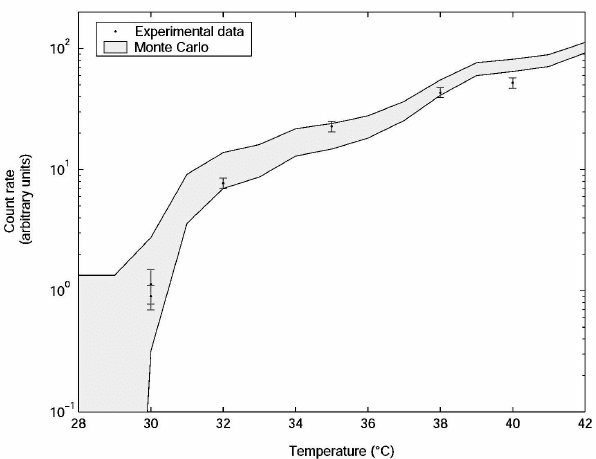
January 9, 2009 10:21 World Scientific Book - 9.75in x 6.5in ws-bo ok975x65˙n˙2nd˙Ed
734 Principles of Radiation Interaction in Matter and Detection
Fig. 10.10 SBD-1000 response (count rate) to 200 keV neutrons as a function of temperature. The
volume of the detector is 8 ml. The simulated response gives a loading of 0.61 ± 0.06% [Barnab´e-
Heider et al. (2004)].
can be neglected. Furthermore, under the assumption that the recoil nucleus trig-
gering vaporization at neutron threshold is fluorine, the dE/dx required to trigger a
phase transition is too high to explain the efficiencies seen in the α case. This is not
completely understood. However, it suggests that the minimal energy deposited at
neutron threshold must be defined by the carbon recoil, as assumed in calculating
the efficiency η (see above). Taking the probability function, Eq. (10.7), and this
minimal energy requirement, the critical length as a function of temperature and
the value of α were deduced from the fit to the data (Fig. 10.9).
A critical length of L = 18 R
c
and α = 1 are necessary to fit these data. This
value of the critical length obtained is not inconsistent with the value found in [Bell,
Oberle, Rohsenow, Todreas and Tso (1973)]. The values L = 18 R
c
and α = 1
are validated from the simulation of the neutron response, using the same energy
deposition and critical length requirements. As an example, the result of the fit to
the data for 200 keV neutrons is shown in Fig. 10.10 for 200 keV neutrons, where the
data at 1 atmosphere are from Fig. 10.2. The simulated response gives a loading
0.61 ± 0.06%, in agreement with the 0.7% loading of the detector used for the
α-particle measurement (Fig. 10.9).
Neutrons, with energy above threshold, produced from radioactivity in the envi-
ronment material or spallation induced by cosmic rays muons, are a possible source
of background for α-particles data. In particular, neutrons are produced by the
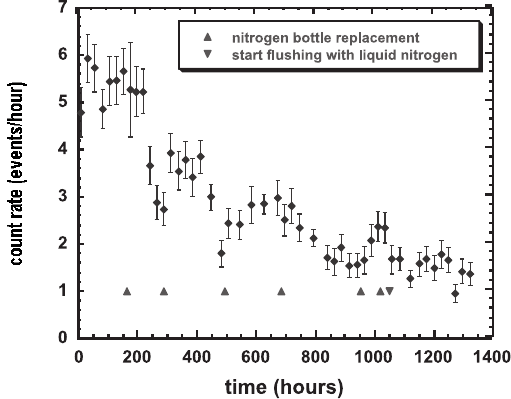
January 9, 2009 10:21 World Scientific Book - 9.75in x 6.5in ws-bo ok975x65˙n˙2nd˙Ed
Superheated Droplet (Bubble) Detectors and CDM Search 735
Fig. 10.11 Background counting rate of 1.5 l detector (loaded with 100% C
4
F
10
) as a function of
time. The background count rate depends on the quality-purity of nitrogen used for flushing. Fluc-
tuation stabilized and minimized with liquid nitrogen boil off [Barnab´e-Heider et al. (2002)].
interaction of cosmic-ray muons with the detector environment, such as shielding,
rocks or concrete walls. In principle, shielding against these background neutrons
can be achieved by their moderation with paraffin or water, bringing their energies
below threshold (< 50 keV at room temperature).
10.1.3 Radon Detection
The superheated droplet detectors can serve for the detection of radon,
222
Rn, from
238
U-decay chain. Radon is a radioactive gas created by the decay of
226
Ra. It
decays further with T
1/2
= 3.85 days, E
α
= 5.49 MeV, to isotopes of
218
Po (T
1/2
=
3.05 min, E
α
= 6.00 MeV),
214
Pb (T
1/2
= 26.8 min, β emitter),
214
Bi (T
1/2
=
19.7 min, β emitter) and
214
Po (T
1/2
= 0.164 ms, E
α
= 7.69 MeV). Thus, radon
is an α-emitter. When present in the detector environment, it can diffuse into the
detector, where it induces an α-signal which can be measured. In the case of an
experiment such as CDM search, radon is a source of background. Flushing the
detector container with pure nitrogen largely reduces radon, achieving a typical
radon count rate of 1–2 events per hour, in the example shown in Fig. 10.11 at
room temperature and at a pressure of 1 atm. Isolation from radon must be secured
during detector fabrication, storage, and operation. Hermetic wall and lid for the
detector container and use of pure compression gas should achieve that goal.
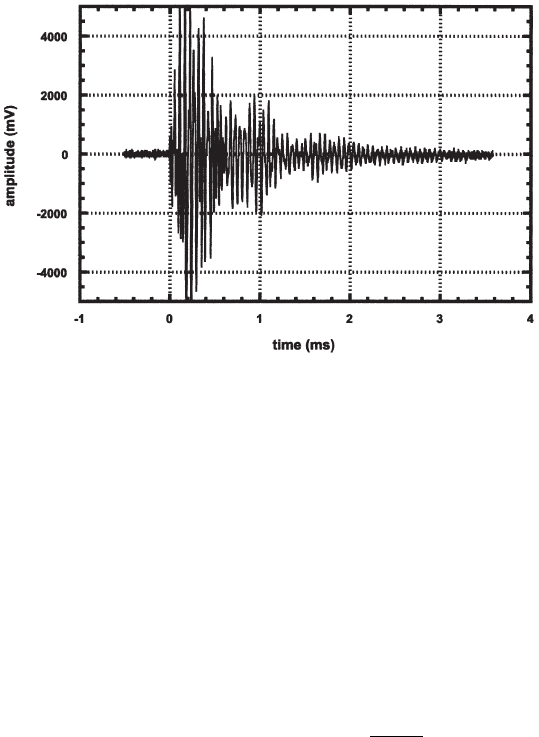
January 9, 2009 10:21 World Scientific Book - 9.75in x 6.5in ws-bo ok975x65˙n˙2nd˙Ed
736 Principles of Radiation Interaction in Matter and Detection
Fig. 10.12 Example of an electrical signal produced by the passage of droplet-to-bubble transition
sound wave through a piezo electric sensor.
10.1.4 Spontaneous Nucleation
In CDM search experiments, a possible source of background events is spontaneous
phase transition due to homogeneous nucleation in the superheated liquid. The
metastability limit of a superheated liquid is described in [Eberhart, Kremsner and
Blander (1975)] and references therein. Vaporization for organic liquids takes place
at an absolute temperature which is about 90% of the critical temperature (T
c
), at
atmospheric pressure. A very rapid decrease of the spontaneous nucleation flux, P
(bubbles s
−1
cm
−3
) with decreasing temperature is expected [Eberhart, Kremsner
and Blander (1975)] and follows an exponential form [Boukhira et al. (2000)]:
P (bubbles s
−1
cm
−3
) ∝ exp
·
−
E
c
(T )
k
B
T
¸
, (10.16)
where E
c
is the critical energy, and k
B
is the Boltzmann constant (see Ap-
pendix A.2). Detectors have been tested in a shielded environment [Boukhira et
al. (2000)]. The temperature dependence of the signal was measured and shown to
decrease by several order of magnitude over a temperature interval of 1
◦
C near the
temperature region T ∼ 0.9 T
c
, where such nucleation should dominate. Therefore,
spontaneous nucleation is not playing any significant role, when the detector is used
at normal operation temperature (often at room temperature).
10.1.5 Signal Measurement with Piezoelectric Sensors
The explosive droplet-to-bubble transition generates an acoustic signal which can be
detected by piezoelectric sensors adapted to the acoustic emission spectrum. These
sensors, two or more, are glued to the surface of the detector container (Fig. 10.1)
January 9, 2009 10:21 World Scientific Book - 9.75in x 6.5in ws-bo ok975x65˙n˙2nd˙Ed
Superheated Droplet (Bubble) Detectors and CDM Search 737
and coupled to high gain, low noise preamplifiers whose frequency response is opti-
mized to suppress lower frequency acoustic noise. An example of an acoustic signal
transformed into an electronic signal is shown in Fig. 10.12.
The signal produced by the explosive droplet-to-bubble transition is transmitted
through the gel as a pressure front, then through the container wall to the piezo-
sensor. The sound velocity in the gel has been measured to be 1600±100 m/s, close to
the sound velocity in the plastic materials used in the container fabrication [Gornea
(2002)]. The signal shapes and frequency responses are dependent on i) the energy
released in the liquid-to-vapor phase transition, ii) the distance traveled by the
sound in the gel leading to signal attenuation as a function of event-sensor distance,
iii) the temperature and pressure of operation and iv) the recording history of the
detector, mainly the number of events that have occurred before the measured signal
since the last compression of the detector. The dependence of the signal amplitude
as a function of the number of events counted after a recompression and pressure re-
lease cycle, for various temperatures of operation, shows a decrease in the counting
and mean maximum amplitude. This reflects the detector depletion, starting with
the largest droplets, fewer in numb er but containing a larger fraction of the active
volume. The amplitude attenuation for various sensor-event distances indicates that
signals can be obtained with adequate efficiency up to 20 cm from the source. The
signal amplitude increases with increasing temperature and decreasing pressure of
operation. This observation follows the expectation that the energy released in a
droplet explosion increases with temperature and decreases with pressure. It allows
one to set well-defined limits on the temperature and pressure ranges of opera-
tion. The piezo-sensors are set to discriminate against low frequency noise, while
favoring higher frequencies useful for timing purpose [Gornea (2002)]. Fast Fourier
transform analysis of pulses within sp ecific frequency windows selected by the sensor
response allows acoustic noise rejection, yielding a clean radiation-induced signal at
a cost of a loss (< 10%) of efficiency.
10.2 Search of Cold Dark Matter (CDM)
In many models of supersymmetry, the neutralino, χ, is assumed to be the Lightest
Supersymmetric Particle (LSP). Particularly, in models of supersymmetry with R-
parity conserved. The R-parity is defined as
R = (−1)
3B+L+2S
for a particle of spin S, baryon number B and lepton number L: R = 1 for Standard
Model particles and R = −1 for the superpartners. The neutralino is stable and re-
garded by many as the most promising candidate for Cold Dark Matter (CDM). Ex-
periments doing a direct search of cold dark matter, like PICASSO [Barnab´e-Heider
et al. (2005a)], SIMPLE [Girard R et al. (2005)], and others, are based on the tech-
nique of detection of nuclear recoils induced in the elastic scattering of neutralino

January 9, 2009 10:21 World Scientific Book - 9.75in x 6.5in ws-bo ok975x65˙n˙2nd˙Ed
738 Principles of Radiation Interaction in Matter and Detection
on a nucleus N [of atomic mass
∗
m
N
and atomic number Z]:
χ + N → χ + N,
as the energy, E
χ
, of neutralinos is very small, for instance E
χ
≈ 40 keV for a neu-
tralino mass of 100 GeV. These experiments measure the neutralino–nucleus cross
section as a function of the neutralino mass (this mass is presently unknown but
expected to be very heavy, 100 GeV or more). The cross sections of these neutralino–
nucleus interaction processes can be divided in two separate types. The coherent
part or spin-independent part, described by an effective scalar coupling between the
neutralino and the nucleus, is proportional to the numb er of nucleons in the nucleus
[i.e., proportional to the square of the mass number (see page 218) of the nucleus
(A
2
)]. The coherent part receives contribution from the scattering of quark,
χ + q → χ + q,
described by the Lagrangian L∼ χχ¯qq. The second part of the neutralino–nucleus
cross section is the incoherent part or spin-dependent part and results from an axial
current interaction of a neutralino with constituent quarks. This interaction, which
couples the spin of a neutralino to the total spin of the nucleus, depends on the spin
of the nucleus and is described by the Lagrangian L∼ (χγ
µ
γ
5
χ)(¯qγ
µ
γ
5
q). Therefore,
depending on the target nucleus atomic mass the experiment can be sensitive either
to spin-dependent or to spin-independent neutralino–nucleus interactions. In parti-
cular, one considers the example of the PICASSO experiment [Barnab´e-Heider et
al. (2005a)], which is measuring the neutralino–
19
F cross section. This cross section
is largely dominated by the spin-dependent contribution. The measurement of the
spin-dependent neutralino–
19
F cross section, as a function of the neutralino mass,
provides neutralino–
19
F and neutralino–nucleon exclusion limits. From the data, one
determines: i) the neutralino–proton and the neutralino–neutron cross sections as
functions of the neutralino mass and, ii) the relation between neutralino–proton and
neutralino–neutron spin-dependent coupling constants. One can also obtain limits
on spin-independent cross section for PICASSO by extracting the neutralino–proton
and neutralino–neutron spin-independent coupling constants from spin-independent
experiments (with large atomic mass m
N
).
10.2.1 Calculation of the Neutralino–Nucleon Exclusion Limits
For experiments based on the technique of nuclear recoils detection, one can express
the differential interaction rate per unit detector mass as (e.g., see [Bottino et al.
(1997); Genest and Leroy (2004); Giuliani (2005)]):
dR
dE
R
= N
T
ρ
χ
m
χ
Z
v
max
(E
R
)
v
min
(E
R
)
f(v)
dσ(v, E
R
)
dE
R
dv, (10.17)
∗
The difference between the nuclear mass and the atomic mass is negligible.

January 9, 2009 10:21 World Scientific Book - 9.75in x 6.5in ws-bo ok975x65˙n˙2nd˙Ed
Superheated Droplet (Bubble) Detectors and CDM Search 739
Table 10.1 value of atomic number Z,
mass number A (see discussion at page
220) and the ratio Z/A for nuclei typi-
cally used in direct searches for dark mat-
ter particle.
Nucleus Z A Z/A
19
F 9 19 0.47
23
Na 11 23 0.48
40
Ca 20 40 0.50
73
Ge 32 73 0.44
127
I 53 127 0.42
131
Xe 54 131 0.41
where E
R
is the recoil energy, N
T
is the number
k
of target nuclei per unit mass;
ρ
χ
is the local density of neutralino(ρ
χ
∼ 0.3 GeV/cm
3
) of mass m
χ
(in units of
GeV/c
2
in Sects. 10.2.1-10.2.2), v is the neutralino velocity in the detector rest
frame, with v
min
and v
max
the minimum and maximum velocities, respectively. The
velocities will be converted into E
R
for the calculations. f(v) is the neutralino
velocity distribution in the detector rest frame and is given by:
f(v) d
3
v =
exp
¡
−v
2
/v
2
0
¢
π
3/2
v
3
0
d
3
v (10.18)
with the velocity dispersion given by
¯v =
v
2
®
1/2
=
µ
3
2
¶
1/2
v
0
≈ 270–280 km s
−1
(10.19)
(v
0
≈ 220–230 km s
−1
). dσ(v, E
R
)/dE
R
is the differential cross section for
neutralino–nucleus scattering and is the sum of two contributions:
dσ
dE
R
=
µ
dσ
dE
R
¶
SI
+
µ
dσ
dE
R
¶
SD
(10.20)
where (dσ/dE
R
)
SI
is the spin-independent (SI) or coherent part of the cross section
and (dσ/dE
R
)
SD
is the spin-dependent (SD) part of the cross section.
10.2.1.1 Spin-Independent or Coherent Cross Section
The spin-independent (SI) or coherent cross section is given by ([Bottino et al.
(1997)], for instance)
µ
dσ
dE
R
¶
SI
=
2G
F
2
m
N
πv
2
[Zg
p
+ (A − Z)g
n
]
2
[F
SI
(E
R
)]
2
(10.21)
where: G
F
is the Fermi coupling constant, G
F
≈ 1.16610
−5
GeV
−2
(Appendix A.2);
m
N
is the nucleus mass, v is the neutralino velocity in the laboratory frame; Z and
A are the nuclear charge and the mass number of the target nucleus, respectively; g
p
k
The number of target nuclei per gram of material isN
T
= N
a
/A
a
, where A
a
is the relative
atomic mass (or atomic weight, i.e., Sect. 1.4.1 and discussion at page 220) of the material and
N
a
is the Avogadro constant. For
19
F, we have A
a
= 19.
